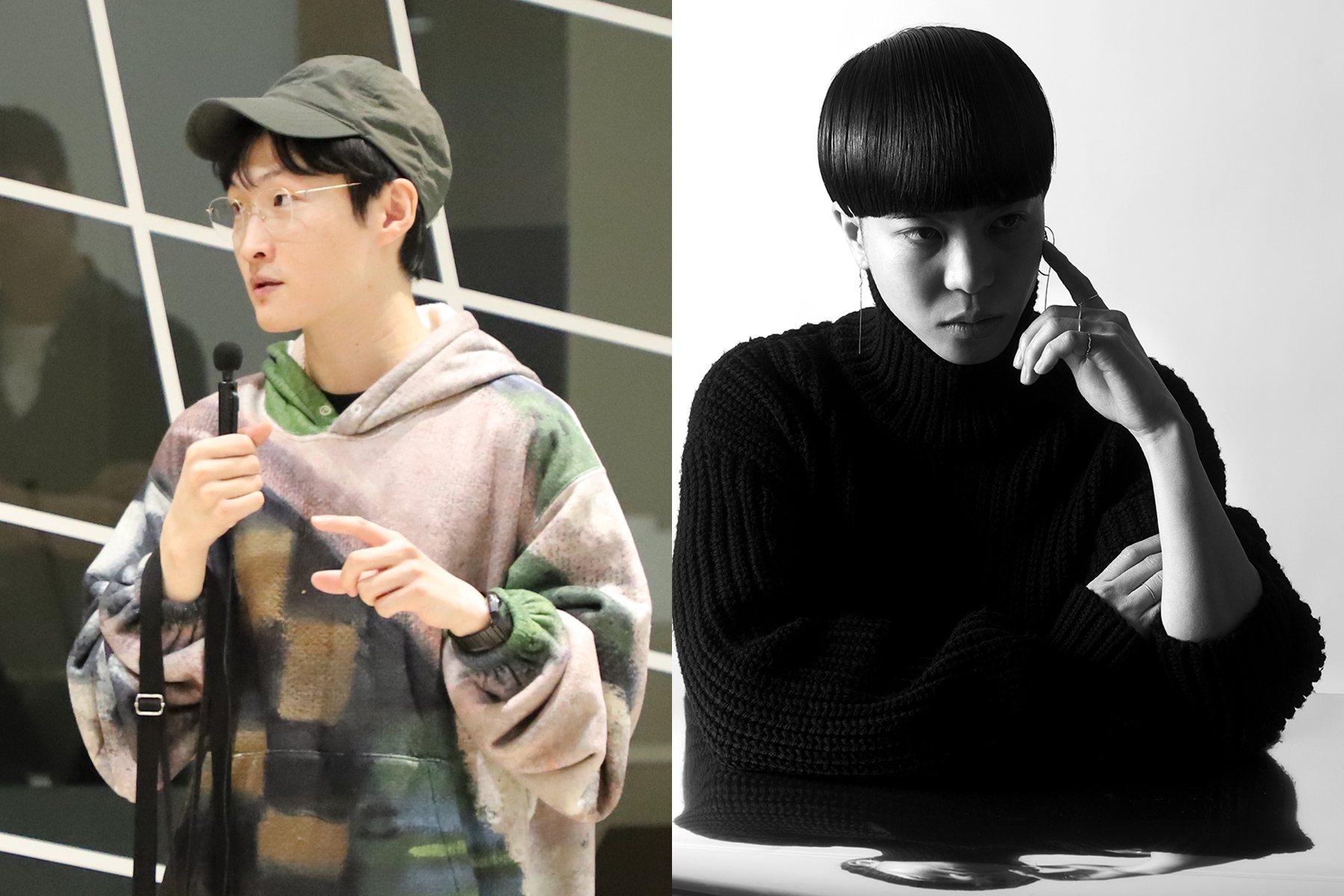《리버스 캐비닛 Reverse Cabinet》 전시서문
윤율리—이와타 토모야와 함께
수집은 세계에 관한 제안이다. 세상의 무수한 파편들 가운데 극히 일부를 골라 정교한 목록을 만들고, 그 목록으로 세계의 질서를 재편하는 것이기 때문이다. 사건, 사물, 이미지의 조각들 중 극히 일부만이 수집가의 목록에 오를 자격을 얻는다. 예술의 역사도 수집의 역사와 깊이 닿아 있다. 박물관의 유리 진열장, 수집가의 신비로운 캐비닛은 한 시대의 미(美)의식을 증명하는 장치이자 무엇이 가치 있는 대상인지를 규정하는 투명한 무대였다. 그 총체인 컬렉션은 선택된 것과 배제된 것이 교차하는 이중의 세계를 역설적으로 암시하는 흥미로운 도구다.
Kiaf SEOUL 2025 특별전 《리버스 캐비닛 Reverse Cabinet》은 수집과 진열이 가진 원초적인 힘을 다시 바라보는 일에서 출발한다. 올해로 24회를 맞은 Kiaf는 현대미술이 놓인 가치의 체계와 자본의 체계가 충돌하고 얽히는 역동적인 장소다. 이곳에서 미술은 관조나 감상의 대상일 뿐 아니라 창작과 소유, 해석과 유통을 망라한 상호작용 속에서 끊임없이 평가받고 재구성된다. 《리버스 캐비닛》은 Kiaf의 이러한 특성을 전시로 불러들여 예술의 방법론이자 형식으로서의 수집과 진열을 조명한다. 특별전 참여 작가인 돈선필, 정금형, 염지혜, 오가영, 다케무라 케이(Kei Takemura), 다카하시 센(Sen Takahashi)는 모두 임의의 수집가로 분해 자신의 작업을 전개해 왔다. 이들의 작업은 개인적인 동기나 취향에 따라 특이한 수집의 논리를 드러내는가 하면, 때로는 견고한 진열장을 뒤집듯 목록 이면의 힘과 구조를 전복하고 낯선 진열의 방식을 취한다. 즉 이들에게 수집과 진열은 미술을 통해 동시대의 삶에서 보이는 것, 보이지 않는 것 모두를 가시화하는 일이며, 제도 내부에서 미술의 가치 체계를 이용하는 창조적 형식이다.
돈선필은 서브컬처가 투영하는 현대성에 관심을 기울여 왔다. 그 문화적 근거로서 피규어, 굿즈와 같은 부산물을 수집하고 수집의 욕망을 매개로 대중문화와 순수미술이 어떻게 공모하는가를 섬세하게 관찰한다. 〈포트레이트 피스트 Portrait Fist〉는 애니메이션에서 흔히 발견되는 ‘얼굴’ 이미지, 극도로 도식화된 캐릭터(Kyara)의 얼굴에 주목해 그것이 개인의 정체성이나 성격을 어떻게 압축적으로 전달하는지를 탐구한다. 그는 얼굴의 표정과 과장된 스타일, 독특한 어투와 같은 특성을 통해 얼굴 이미지가 신체의 일부를 넘어 개인의 운명과 정치적 입장, 나아가 하나의 문화적 시기를 대리하는 기호가 된다고 본다.
정금형은 기계, 인형, 일상의 사물을 자신의 신체와 결합함으로써 인간이 사물과 맺고 있는 익숙한 관계를 비판적으로 성찰해 왔다. 그의 컬렉션에 등장하는 사물은 수동적인 관찰의 대상이 아니라 인간-신체와 적극적으로 교감하며 스스로 살아있는 존재로 작동한다. 〈컨디션 체크 Condition Check〉와 같은 전작은 미술관 수장고를 주제로 사물이 보존 및 관리되는 방식, 제도적으로 일반화된 유통-소유의 메커니즘을 탐구했다. 수장고는 본래 사물의 생명력을 고정하고 영구히 보존하는 장소지만, 정금형에게 그것은 인간과 사물, 생명과 비생명의 경계가 흐릿해지는 흥미로운 시공이다.
염지혜는 신화, 과학과 같은 ‘거대한 서사’로부터 영감을 얻고 파편을 추출하는 미디어 아티스트다. 이것은 그가 비디오와 영상 설치라는 형식을 활용해, 과거의 기억을 복원하는 것을 넘어 서로 다른 서사가 충돌하고 뒤섞여 만드는 ‘다른 현실’을 탐색하는 방편이다. 〈검은 태양 X : 캐스퍼, 마녀 그리고 물구나무종 Black Sun X: Casper, Witch, and Handstanderus〉은 세 가지 이질적인 서사—대중문화 속 사랑스러운 유령 캐릭터 ‘캐스퍼’, 흑사병 이후 초기 자본주의로의 전환기 속 발생한 마녀사냥, 식물과 같은 사고방식을 모색하는 집단 ‘물구나무종(Handstanderus)’—를 연결하며 역사적인 재앙이 현재 우리의 삶과 어떻게 얽혀 있는지 되묻는다. 〈분홍돌고래와의 하룻밤 A night with a Pink Dolphin〉은 그가 아마존 정글에서 분홍 돌고래를 마주한 경험으로부터, 돌고래에 얽힌 민속적 전설과 식민의 역사, ‘분홍 돌고래’라는 기이한 생명종이 소비되는 방식을 다층적으로 드러낸다.
오가영은 도처에 부유하는 디지털 이미지를 수집하고 이를 사진-조각이라는 물질적 체계로 전환함으로써 이미지가 신체적 경험에 개입하는 순간을 증폭한다. 이러한 그의 작업은 사진, 조각, 설치 등 다양한 매체를 넘나들면서 이미지 자체뿐 아니라 그것이 딛는 매체적 조건을 수집하고 진열하는 것이라 부를 수 있다. 이번 전시에서 재구성한 〈해프 스티키 Half Sticky〉 연작은 그가 도시를 거닐며 스마트폰으로 자연의 파편을 수집한 뒤, 이를 전시 환경에 맞추어 변형하고 재배열한 결과다. 여기서 사진은 무언가를 기록한 이미지에 머무르지 않고 임시 가설물과 같은 지지체와 결합하여 입체적인 사진-설치로 변모한다.
한편 일본의 두 작가, 다케무라 케이와 다카하시 센은 수집과 진열의 근본적 의미를 각기 다른 방식으로 탐구한다. 다케무라 케이는 파손된 일상 사물과 그 조각을 섬세하게 수집한 뒤 비단실로 정성스럽게 꿰매고 감싸는 작업을 지속해 왔다. 그의 진열장은 사물 본연의 기능이나 물리적 형태보다 그것이 지닌 기억과 흔적을 더욱 섬세하게 보존하며, 망각의 경계를 넘어 우리가 잃어버린 것을 촉각적으로 감각케 한다. 한때 청동 조각 보존·수복 전문가로 일한 다카하시 센은 사물에 부여된 소멸의 필연성을 개념적으로 수집하고 진열한다. 그의 컬렉션에서 사물은 시간이 지남에 따라 점차 부패하고 소멸해 가는 과정을 있는 그대로 드러낸다. 그의 ‘부패하는 컬렉션’은 시간과의 긴장 속에서 작품과 컬렉션의 의미가 끊임없이 변화한다는 점을 보여주며, 영원을 향한 진열장의 환상을 재고한다.
‘진열장을 뒤집는다’는 진술은 진열의 물리적인 재배치만을 의미하지 않는다. 작가들은 저마다 특이한 컬렉션의 형식을 통해 우리가 믿어 온 기존의 질서를 조용히 뒤집고, 선택과 배제, 기억과 망각이 얼마나 불안정한 경계 위에 놓여 있는가를 명확히 드러낸다. 관객은 이들이 구상한 진열장 사이를 거닐면서 궁극적으로 무언가를 뒤집는 미술의 방식을, 그리고 뒤집힌 세계의 기이한 매혹을 경험할 것이다. 이처럼 《리버스 캐비닛》은 우리가 아직 맞닥뜨리지 못한 현실의 목록이기도 하다. 그 목록 너머에서 수집가들은 더 풍부하고 미묘한 수집의 가능성을 찾는다. 전시의 마지막 제안은 이렇듯 세계가 언제든 다시 수집될 수 있으며, 그 새로운 목록의 진열이 바로 우리 자신에게 열려 있다는 가능성의 자각이다.
전시기획: 윤율리, 이와타 토모야
프로젝트 매니저: 김지선


